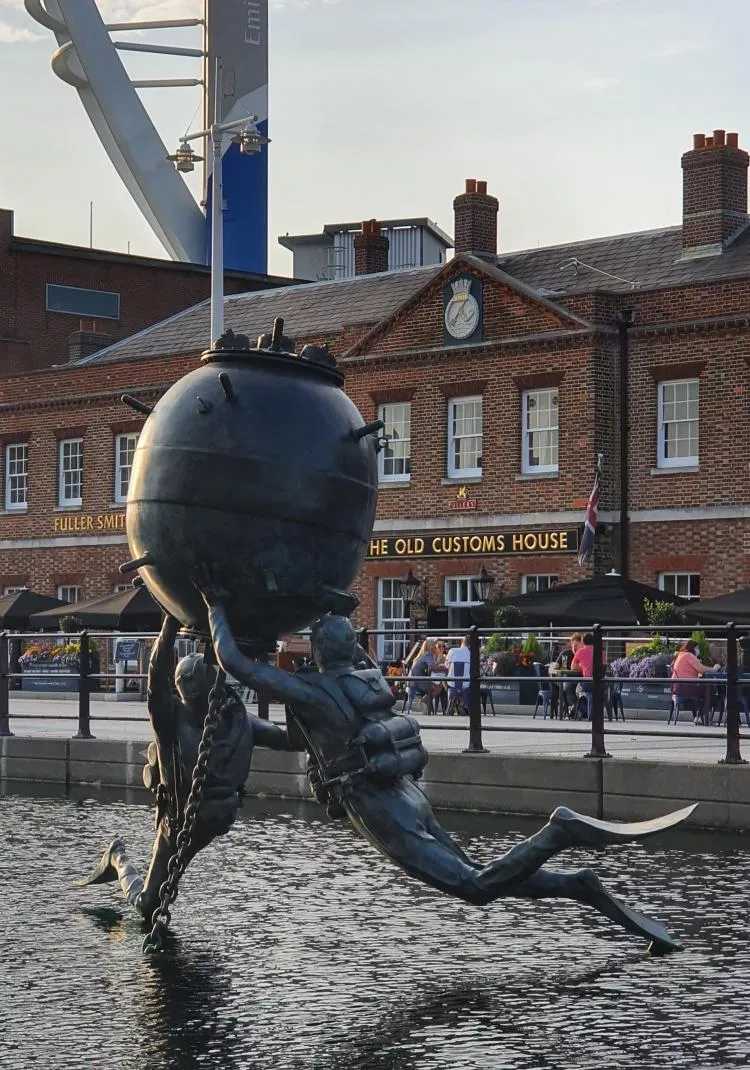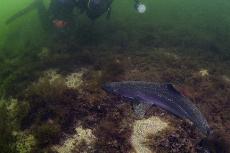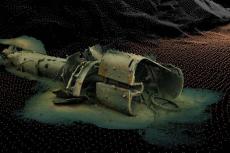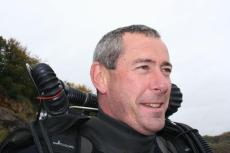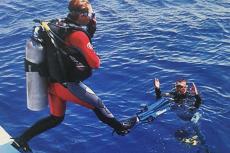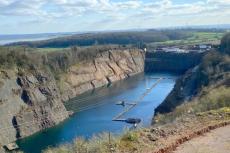A monument for all involved with mine warfare and diving to be officially dedicated
A date has been set to dedicate a monument that honours mine warfare and diving personnel, and immortalises the memory of 'HMS Vernon', a former naval base in Portsmouth, England.
At present, the dedication event at Gunwharf Quay is provisionally pencilled for Friday, 15 July 2022. The summer date has been chosen, because it is anticipated that Covid-19 will be less of an issue. That being the case, it is hoped that current and former Royal Navy Clearance Divers will be allowed to take part in this important occasion.
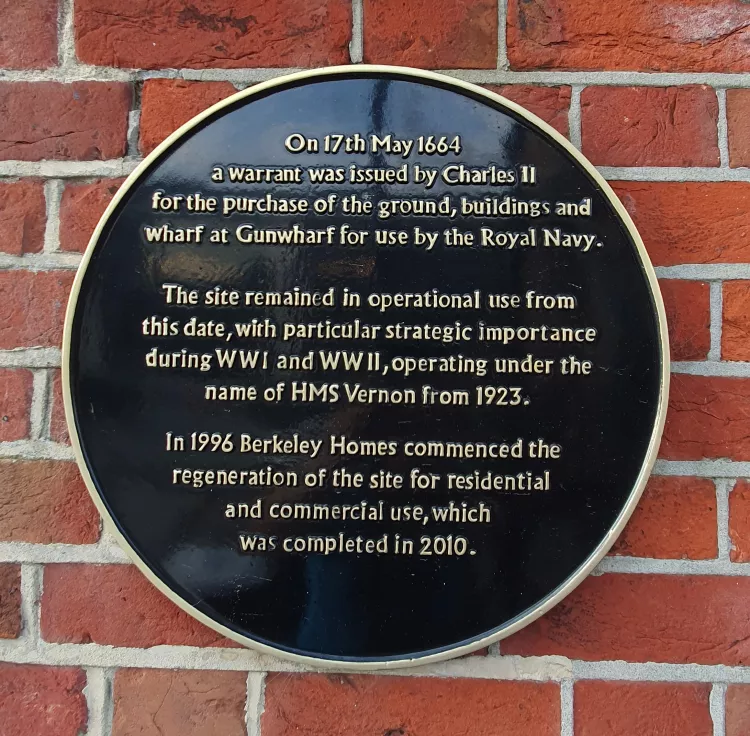
HMS Vernon
Today, most visitors to the waterfront outlet shopping destination 'Gunwharf Quays' in Hampshire do not realise the site has a long naval history.
Gunwharf was built on reclaimed land in Portsmouth in approximately 1706. The wharf acted as a main repository for the Royal Navy—supplying and maintaining guns, small arms, cannonballs and other ordnance—hence, it gained the name 'Gunwharf'.
Jump forward three centuries, and Gunwharf was still dealing with ordnance, this time in the shape of mines and torpedoes. The Mine School had taken over the southern end of Gunwharf in 1919, followed later by the Torpedo School in the northern end. By 1923, the whole of Gunwharf was known as the Vernon Shore Establishment.
HMS Vernon / Gunwharf became synonymous with the torpedo and the mine. This is because in 1867, the torpedo was considered a variety of mine, therefore the two weapons were developed alongside each other.
We wanted something to show the naval heritage of HMS Vernon because there was nothing. Rob Hoole, former Royal Navy Clearance Diver
Former Royal Navy Mine Warfare and Clearance Diving Officer Rob Hoole stated that "during WWII, HMS Vernon became responsible for mine disposal and mine countermeasures. However, it wasn't until 1 October 1944 that Minewarfare (mining and mine countermeasures) and naval diving were brought under the same organisation."
HMS Vernon was the spiritual home for the Royal Navy Clearance Divers (CD) from 7 March 1952, when the Branch was officially formed under Admiralty Fleet Order (AFO) 857/52. Former Royal Navy Clearance Diver Ginge Fullen told me that prior to the official launch, at least 60 to 70 CD divers had trained and been qualified at HMS Lochinvar, on the Firth of Forth. Ginge Fullen believes that to date, approximately 3,000 Clearance Divers have been trained.
Training in diving, demolitions and minewarfare continued at HMS Vernon until the mid 90s. On 1 September 1995, diver training, along with the clearance diving teams, moved to Horsea Island located at the north of Portsmouth. Two months later, in November 1995, minewarfare was moved, and eventually ended up at HMS Collingwood. The Royal Naval site (formerly known as HMS Vernon) closed its doors for the last time on 1 April 1996.
For nearly 75 years until 1996, the site was dedicated to training clearance divers and the home of the Royal Navy’s world-leading mine warfare specialisation. Royal Navy
Unveiling cancelled by Covid-19
It was hoped that Prince Harry would unveil the monument in a special dedication ceremony in 2020.
Eight hundred guests, including several veteran minewarfare and diving personnel, had been invited to attend Gunwharf for the commemoration on Wednesday, 25 March 2020.
At the time, Prince Harry was 'Commodore-in-Chief, Small Ships and Diving'. This would have been one of the last events that Prince Harry could have conducted in this role before he retired from public life, and returned his military appointments to the Queen. Sadly, this event was cancelled because of the coronavirus pandemic.
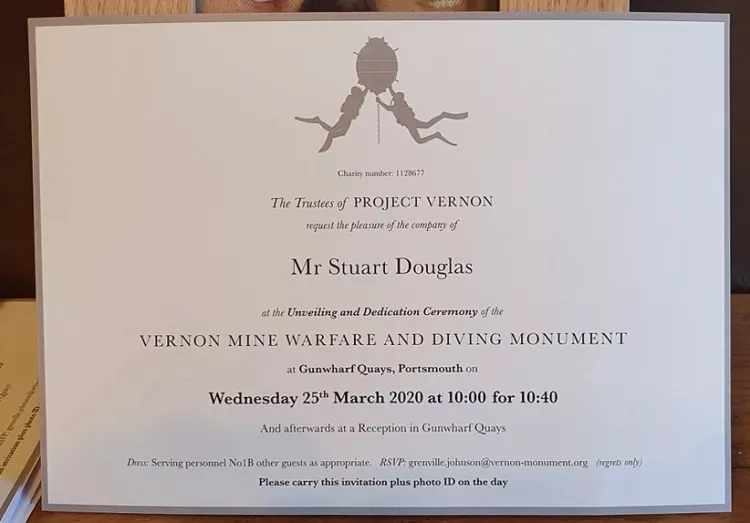
From this evening I must give the British people a very simple instruction—you must stay at home. Boris Johnson, PM
On 16 March, Boris Johnson, the UK Prime Minister, advised everyone in the United Kingdom against "non-essential" travel and contact with others. This escalated into a full lockdown on 23 March 2020, when Boris Johnson stated "From this evening I must give the British people a very simple instruction—you must stay at home."
The quick decision was made for the monument to be unveiled in a low-key scaled-down service by Commodore Jeremy Bailey, commander of Portsmouth Naval Base on Tuesday, 17 March 2020. Commodore Bailey was supported by specialists from the navy’s elite Fleet Diving Squadron, and the ceremony was informally streamed on social media.
Rob Hoole, who was based at HMS Vernon, stated "We’re all really pleased that it is finally there. We’re bitterly disappointed that we had to scale back the unveiling but it was the most sensible thing to do."
A Clearance Diver is born
Due to the fact that HMS Vernon specialised in mine warfare, all mine divers were trained here. Whilst writing this article, I asked former Royal Navy Clearance Diver (CD) Stuart Douglas what it was like to be based at this naval establishment.
"As a student you didn't want to spend much time at HMS Vernon. We would do our classroom training there, and our water training at Horsea Island. Typically if you were in the office (Vernon), you were in trouble, so we'd tiptoe down the main admin corridor, and try not to be spotted.
The training at Horsea was bloody horrible. Ginge Fullen has written an accurate description of what went on [look in the attachments section at the bottom of this article to read it]. We didn't dive for the fun of it. You passed your navy clearance diver course in spite of the instructors' best efforts to put you off with constant beasting circuits, swimming, mud runs and diving around the clock.
When I became a CD (Clearance Diver), I was drafted to the Bomb Squad. We were based at HMS Vernon near the water's edge. Today, it is where the pontoons are secured at Gunwharf. The team were hard working and we were on 24-hour pager call to respond to EOD (Explosive Ordnance Disposal) and IEDD (Improvised Explosive Device Disposal). Our patch was from Weymouth, Dorset to Whitby, Yorkshire and at least three times a year we would call in at every Police Station and Coastguard Office to collect out-of-date flares and other devices, and then dispose of them. We would do a lot of underwater engineering jobs, and it was not unheard of to be diving for a minimum of six hours. Long days.
I then joined the Fleet Clearance Diving Team in 1989, and was again based at HMS Vernon. Once more, I was on 24-hour call-out with this rapid response team. A Lockheed C-130 Hercules was always on standby at RAF Brize Norton, and we would be deployed anywhere in the world to support our fleet abroad."
The mentality of your average Clearance Diver
Former Royal Navy Clearance Diver Ginge Fullen has written a number of articles about life as a Clearance Diver. They include Yorky Wilkinson—The Suez Crisis of 56, Carl Massey—In Troubled Waters and Diver Hilton—Those who came before us.
Stuart Douglas shared a couple of stories with me.
"Probably one of the most memorable operations was in Puerto Rico. Somehow one of our Type 21 or Amazon-class frigates had managed to snap a propeller blade. This blade weighted about one and a quarter tonnes. We had to get the stub of the old prop out, and refit the new one. This was all done underwater. We worked day and night, in six hour shifts. From the first person going in, till the last one coming out, it took us 23 hours to accomplish this exceptional task. It was a test of how effective and efficient we were. We grafted. The training and experience I gained at HMS Vernon, certainly paid off."
Stuart Douglas served in the first Gulf War. In February 1991, he was in Kuwait. "Our role was to make the Kuwaiti ports safe. We started off living in cargo containers dockside, and diving the main harbours and the areas around the ports of Kuwait, clearing them of ordnance and bodies.
Diving was a particularly difficult task as the water surface was covered with a 'skin' of oil, up to 1" thick, which coated everything, suits, sets, exposed skin, the lot. We cleaned our diving sets with swarfega and brooms, drawing bemused looks from the USA divers, whose kit was all electronic and didn't like the horrible conditions. Ours, on the other hand, was pretty much unchanged from the 1940's and could withstand some serious abuse! It took us days to clear leftover ordnance from the harbours, buildings and trenches, and removing anti personnel mines from the beaches around the city
This was the first time that Allied ships would be coming alongside since the start of the conflict so someone decided that there should be a parade to mark this. The world's press and TV was there to film the occasion and, from somewhere, someone had mustered up a brass band for the occasion! As the ships pulled alongside, the band started playing 'New York, New York' and, almost as one all the divers started doing the high kicks associated with this song. All the press and cameras suddenly lost interest in the ships coming alongside and all the top brass there to mark the occasion and started filming us doing a chorus line dance! Needless to say, the powers that be were somewhat less than impressed that their thunder had been well and truly stolen by a bunch of scruffy, unshaven, oil stained divers doing a stupid dance. That was one of the traits of the branch. It was all character building stuff. No matter how bad things were or how knackered you were, you could always find something to have a laugh about with a good team of blokes."
Funding The Project
An idea was floated several years ago that HMS Vernon and the people who served, based and trained there ought to be acknowledged. Fundraising commenced in 2008 to turn dreams into reality.
Contributions towards the monument came from several organisations. In addition, thousands of individual donors sponsored events, attended dinners and talks, dropped money into collecting boxes and buckets at open days, purchased merchandise and bought raffle tickets or bid at auctions. It took 12 years to raise more than £250,000 to pay for the design, build and fit the installation. The grit, effort and time involved with this significant fundraising should not be overlooked or dismissed lightly.
The Design
As is the norm with a project like this, it has not been the smoothest process. Owing to the unacceptably escalating cost, the first monument design was not used.
The second design needed to be suitable, representative, fully viable, timescale achievable and meet the budget
Four new sculptors were briefed that the essence of the winning design should involve a mine and a diver. On 4 October 2018, the sculptors presented a mockup model to the selection panel. (Members included the Minewarfare and Clearance Diving Officers Association, the Minewarfare Association, the Association of Royal Navy First Class Divers and the Ton Class Association).
HMS Vernon Minewarfare & Diving Monument
In March 2019, sculptor Mark Richards FRSS was awarded the commission to design, create and install the Vernon Minewarfare & Diving monument. Mark Richards specialises in figurative work, having been trained in architectural sculpture. It is obvious having seen the statute for myself that Mark Richards actively collaborated with the project team to sculpt the monument. The attention to detail is high and impressive. For instance during the creative process Mark Richards cast his hands as a reference. He wrote on his blog "I'm keeping the pressure on while the plaster goes off to emulate the force of the mine in a tidal flow on a hand."
The bronze was cast at the Morris Singer Foundry in Alton, Hampshire. The sculpture was installed in one day with the assistance of a variety of Project Vernon supporters, including a retired Royal Engineer officer. The process was overseen by Mark Richards. Much of the day was spent anchoring the monument's supporting framework to the bottom of Pool B, and then mounting the sculpture on top, so that it appears to stand proud or float above the sea water.
It gives you a sense of movement and likeness of the divers. It looks like they’re floating above the water. Rob Hoole
The one-and-a-quarter size bronze features two clearance divers wearing the iconic CDBA equipment (Clearance Diving Breathing Apparatus). This is a closed and semi-closed rebreather mix set that could be rigged to deliver oxygen at a constant flow for covert work. Alternatively, it could be dived with all oxygen / nitrogen mixtures, ie O2 60 / 40 mix (good for 24 m / 78 ft), a O2 40 / 60 mix (good for 42 m / 137 ft) or a 32.5 / 67.5 mix (good for 54 m / 177 ft). The two Royal Navy divers are attaching an explosive pack to a moored British MK 17 contact mine. Respectively, these elements represent members of the mine warfare and diving community and celebrate their work—past, present and future.
The Response
People in Gunwharf are stunned by it. They think it’s beautiful. Portsmouth News
Yvonne Clay, Yvonne Clay, senior marketing manager at Gunwharf Quays, told Portsmouth News "the shopping hub had a ‘rich and unique naval history’. We’re delighted to have been able to provide a fitting and authentic home for the new monument."
I wouldn't want to dive near one of those things ... them spiky things could take your eye out if you bumped into it. RN CD
Former clearance divers also made their feelings very clear in social media. Their unique humour clearly indicates that the monument is proudly and heartly approved of.
Now think about doing it at night, in a 2 metre swell ... and still try not to bump the spiky things. RN CD
Not Just Service Divers
It is important to note that whilst this is a statue of two divers, the monument acknowledges many personnel. It honours those involved in naval mine warfare, service diving and bomb and mine disposal—past, present and future. On the diving front, it celebrates the work of Search & Rescue divers, experimental deep divers, Royal Engineer divers, Ship's Divers and of course, Clearance Divers.
This monument honours all involved in mine warfare, diving, and bomb and mine disposal—past, present and future. Stuart Douglas Former Royal Navy Clearance Diver
Former Royal Navy Clearance Diver, Stuart Douglas told me "There has been a lot of blood, sweat and tears shed at Gunwharf. Several people from here have gone on to have prestigious careers in the special forces, or commercial diving world. Having a monument here means so much. It makes people aware that Gunwharf is not purely a shopping centre, it was an important Royal Navy base. This suitably honours all those involved in mine design, mine laying, sweeping and hunting, or who served on mine countermeasures vessels—past, present and future."


